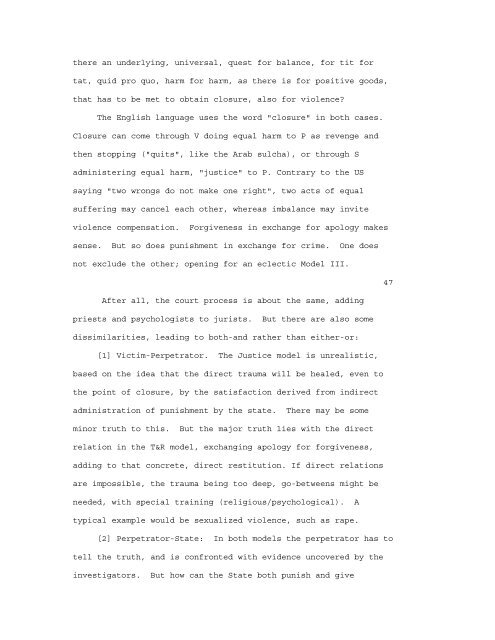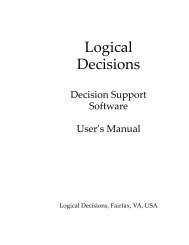AFTER VIOLENCE: 3R, RECONSTRUCTION, RECONCILIATION ...
AFTER VIOLENCE: 3R, RECONSTRUCTION, RECONCILIATION ...
AFTER VIOLENCE: 3R, RECONSTRUCTION, RECONCILIATION ...
Create successful ePaper yourself
Turn your PDF publications into a flip-book with our unique Google optimized e-Paper software.
there an underlying, universal, quest for balance, for tit for<br />
tat, quid pro quo, harm for harm, as there is for positive goods,<br />
that has to be met to obtain closure, also for violence?<br />
The English language uses the word "closure" in both cases.<br />
Closure can come through V doing equal harm to P as revenge and<br />
then stopping ("quits", like the Arab sulcha), or through S<br />
administering equal harm, "justice" to P. Contrary to the US<br />
saying "two wrongs do not make one right", two acts of equal<br />
suffering may cancel each other, whereas imbalance may invite<br />
violence compensation. Forgiveness in exchange for apology makes<br />
sense. But so does punishment in exchange for crime. One does<br />
not exclude the other; opening for an eclectic Model III.<br />
After all, the court process is about the same, adding<br />
priests and psychologists to jurists. But there are also some<br />
dissimilarities, leading to both-and rather than either-or:<br />
[1] Victim-Perpetrator. The Justice model is unrealistic,<br />
based on the idea that the direct trauma will be healed, even to<br />
the point of closure, by the satisfaction derived from indirect<br />
administration of punishment by the state. There may be some<br />
minor truth to this. But the major truth lies with the direct<br />
relation in the T&R model, exchanging apology for forgiveness,<br />
adding to that concrete, direct restitution. If direct relations<br />
are impossible, the trauma being too deep, go-betweens might be<br />
needed, with special training (religious/psychological). A<br />
typical example would be sexualized violence, such as rape.<br />
[2] Perpetrator-State: In both models the perpetrator has to<br />
tell the truth, and is confronted with evidence uncovered by the<br />
investigators. But how can the State both punish and give<br />
47
















